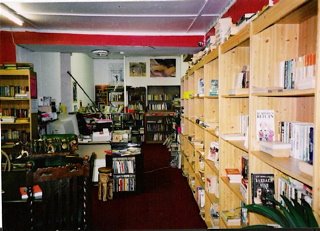An old and sadly only too familiar tale for anyone who's ever been in business, I'm sure. But even reminding myself how I came to be so grindingly poor does not eradicate the little spark of nostalgia and fondness which leapt inside me as I viewed the photos of my old bookshop.

It really was a curiosity shop too, as you may be able to see from these photographs: strange prints on the wall, of nudes and who knows what else; a pair of elephant stools, hand-carved and painted; an exotic carved wooden wall-frieze; books sprawling everywhere, from cheap 60s & 70s 'Confessions of a Window-Cleaner' pulp fiction, to Modern Firsts of well-known twentieth-century poets, to antiquarian editions of Milton and Darwin; an impressive collection of occult literature - a local preacher came in one day and bought The Witch's Bible in order to burn it; an antique dark wooden settle for readers to relax on whilst browsing, and a large centrepiece table with an assortment of chairs for writing workshops and other social events.

Camelford was not ready for a bookshop, however. Rather like the bare platform in the poem 'Adlestrop', nobody came and nobody went for the first six months. A few local browsers would drop by in their lunch hour, engage me in idle talk, then disappear without parting with a penny. Once, a man in a weary-looking suit came in, poked around for a while, then smiled over the desk and told me that nobody reads books on the Cornish side of the Tamar. He was a bookseller from Devon.
One of my most serious problems was that I had little money for advertising, running a few poetry events instead to raise the shop's profile in the community, yet still failing to make enough in sales to cover the rent, rates and other outgoings. But I still maintain the shop failed because it was in too tough a location to draw regular custom - beyond the main body of the village, on a steep and dangerously busy hill, with almost no pavement. Even the Indian King Arts Centre, situated almost directly opposite, was struggling at the time and later closed down.
After I left, there was an art gallery there for a while. When we last drove past the shop, on holiday in Cornwall about a year ago, that too had gone.
4 comments:
It's a shame it didn't work out - looks like a cosy wee place, the kind of place I love to mull about in!
Thanks for saying so, Sorlil. Anyone who's a fan of Crowded House is a friend of mine ...
And thanks for stopping by and leaving a comment. It's really appreciated. Do come again.
Happy days!
Jane
Just discovered that the Indian King Arts Centre, run by Helen Jagger Wood, definitely closed down just after my bookshop, since it is now a rather posh restaurant with B&B accomodation above. If I can run to the cost of a meal there, I'll drop by next time I'm in Camelford (later this summer, possibly) and try them out. Though looking at the prices, maybe I'll have a bar snack instead. A very modest bar snack. Home-made pork scratchings or something ...
For those interested in such things, 'Ravals' is the name of that new restaurant in Camelford ...
"The building’s current name is ‘The Indian King’. This dates back to the 18th century, when in 1734 Tomo Chachi a Cherokee Indian King, his wife Senauki and Tooanakowki their son were brought over from Georgia, North America. Historic records show they travelled the country starting from a Cornish port and these picturesque characters would have aroused great interest at the places they stayed at en route. In 1735 the name was changed to the ‘Higher King's Arms’, and by the 19th century it was simply known as the ‘King's Arms’ and the name of the building has now come back full circle to ‘The Indian King’ which was most recently a community arts centre before it’s conversion into Raval’s.
At present the building is being used as a Restaurant and Bed and Breakfast, but its original use was a Public House in the 17th century."
From Raval's website, the restaurant on the site of the former Arts Centre opposite my little bookshop in Camelford: Ravals. I hope they get enough business to survive - outside the holiday season, it can be tough going for the more expensive restaurants, as the locals can rarely afford them and there is little in the way of 'passing trade' in a place like Camelford.
Post a Comment